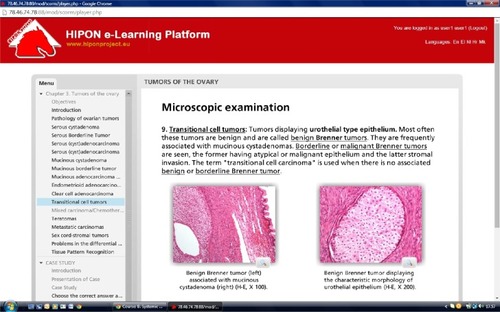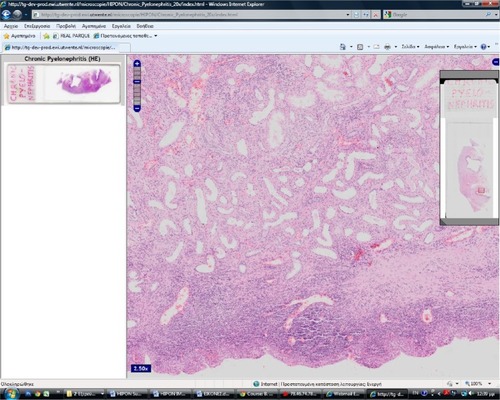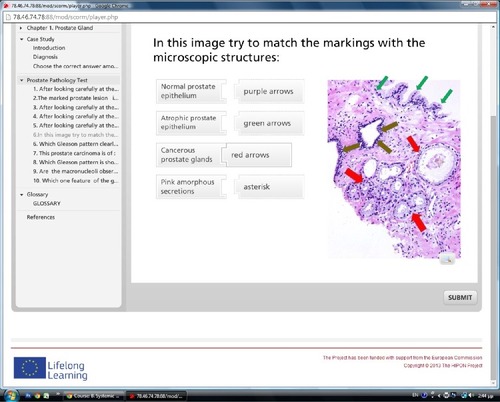Abstract
It is indisputable that nowadays one of the hardest and most important tasks in medicine and especially in medical education, is the conversion of the extensive amount of available data, into medical experience, after a proper analysis. A project under the title “ICT (Information and Communication Technology) eModules on HistoPathology: a useful online tool for students, researchers and professionals – HIPON”, co-financed by the Lifelong Learning Program of the Education, Audiovisual and Culture Executive Agency (EACEA), The Commission of the European Union, has been launched at the beginning of 2013. HIPON’s purpose is not to provide just another pathology website atlas, but to convey professional experience and thinking in pathology. HIPON has resulted in a well-structured and user-friendly, open resource, multi-language, e-learning platform which, taking advantage of modern image technology, offers medical students, researchers, and professionals a valuable teaching instrument so that they can acquire professional experience in pathology. The mid-term report of HIPON has been favorably evaluated by the EACEA experts who appreciated the potential of our teaching tool in providing the opportunity and the means to acquire medical experience. Through the use of virtual slides, educative videos and microscopic, high resolution, marked images accompanied by relevant questions and answers, HIPON project aims to make end-users able to think as experienced pathologists and become highly efficient in correlating pathologic data with other clinical-laboratory information.
Video abstract
Point your SmartPhone at the code above. If you have a QR code reader the video abstract will appear. Or use:
Introduction
Nowadays, pathology represents a major diagnostic field in medicine. Through the analysis of tissue samples, ie, biopsies and surgical resections, it allows medical doctors to exclude or confirm a suspected clinical diagnosis, such as cancer, and even to identify the presence of unsuspected concurrent diseases. The pathological examination of specimens under the microscope may be supported by further, tissue-based laboratory tests such as those making use of molecular biology techniques. A high level of competence in recognizing patterns of injury when tissue specimens are approached, and in correlating the essential pathological data with other clinical-laboratory information is of vital importance to ensure that the correct diagnosis is made.
The role that pathologists have in patient care is indeed crucial, since they are responsible for documenting fully the diagnostic evidence tissue samples can provide. For example, the pathologist’s interpretation of a tumor specimen is critical to establish the diagnosis of a benign or a malignant tumor, to distinguish between distinct histogenetic types of neoplasia, as well as to estimate the grade and the stage of the malignant neoplastic disease. All information provided by pathologists determines patients’ prognosis and efficient treatment selection.
It may take over 14 years to become a fully qualified pathologist. Being part of fundamental medical knowledge, pathology is currently taught, mainly on a theoretical basis, from the undergraduate level of medical studies. Attending lectures and taking advantage of excellent textbooks and atlases, students are supposed to learn how to recognize state of disease and describe main patterns of tissue injury. In their professional life, pathologists and researchers are requested to evaluate microscopic diagnostic features in patients’ tissue sections so that a definite diagnosis is set.
In the immense field of modern pathology, an extensive amount of data is available; so, as many practical skills as possible need to be developed by medical professionals. After discussing and implementing teaching strategies in pathology and evaluating students’ learning, teachers are developing new-style pathology courses.Citation1
In recent years, e-learning tools have been developed to supplement traditional text-based materialsCitation2 and are being progressively included into medical education,Citation3 due to their teaching potential; the relevant educational methods, in which students are requested to be active searchers of knowledge instead of passive recipients,Citation4 have been shown to be associated with increased learning outcomes, with regard to various areas of health and medical education.Citation5,Citation6
It is indisputable that simulation is a promising pedagogical tool in medicine.Citation7 A new teaching approach based on online case studies and interactive discussions, has already been considered successful in teaching pathophysiology.Citation8 The motivation to learn is greatly improved by the study of cases;Citation9 the latter makes pathology easier to understand and, furthermore, in this way, students can relate knowledge to a real world context and their future profession.Citation10
The main characteristics of the modern pathology module consist of digitalized pathology images combined with web-based delivery of compact and guided learning courses. If we consider that changes are occurring from traditional microscopy towards examination of scanned slides, we understand the importance of a teaching approach based on new technological devices.Citation11
The HIPON project
Based on the above, an educational project on histopathology entitled “ICT eModules on HistoPathology: a useful online tool for students, researchers and professionals – HIPON”, co-financed as a key activity 3/ICT project of the Lifelong Learning Program of the Education, Audiovisual and Culture Executive Agency (EACEA), The Commission of the European Union (reference number: 531203-LLP-1-2012-1-GR-KA3-KA3MP) has been launched at the beginning of 2013.
HIPON integrates the new virtual microscope/e-learning environment in multiple educational units/chapters of pathology, specifically tailored to the needs of students (undergraduate, graduate, and postgraduate students), researchers, and professionals.
The project has hopefully resulted in a well-structured and user-friendly, open resource, multi-language e-learning platform with brief texts and extended microscope, high quality image collections, supported by educational videos and relevant virtual slides. High pedagogical experience is included in the courses so as to convey a way of thinking and experience, instead of mere information.
HIPON purpose
HIPON’s purpose is not to provide just another pathology website atlas, among the excellent existing ones, but to pass on professional experience and thinking in pathology. Medical students are required to learn and retain vast amounts of knowledge on the path to becoming physicians;Citation2 nowadays one of the hardest and most important tasks in medical education is the conversion of the extensive amount of available data into medical experience.
Building and putting together knowledge, skills, and attitudes is one of the project’s biggest aims. Authentic learning is improved by the use of case studies and real world problem solving. Learning authentically implies that users are confronted with simulations of their present or future professional practice and are therefore stimulated to develop proper competencies.Citation12
Aristotle once said, “For the things we have to learn before we can do them, we learn by doing them”. Based on preliminary testing results, HIPON focusing on experiential learning appears to contribute to medical education.
HIPON evaluation
The mid-term report of our project has recently been evaluated by the EACEA experts who appreciated the potential of our teaching tool in providing the opportunity and the means to acquire medical experience.
Discussing the value of e-learning, a major issue is the potential difference in material quality, communication skills, and digital setup.Citation13 According to EACEA quality assurance, HIPON’s evaluation has been considered as most satisfactory; the mid-term report acknowledges significant and valuable project results.
In detail, several criteria, such as objectives, results and products and coherence between work plan and activities carried out during the life of the project, have been considered. With regard to the former, the EACEA evaluators have asserted that:
The HIPON initiative remains highly relevant to the program in its very good address to supporting students and developing professionals in histo- and cyto-pathology. The project activities are completely in accordance with its aims. The HIPON architecture is highly appropriate to the project objectives, and can be seen to explicitly respond to the features evident in the needs analysis. Similarly, the initial content responds to user needs.
Going on, for each of the evaluated criteria, comments have been made and a score was assessed; the global HIPON score hovered around the level of 90%. In conclusion, an overall evaluation was provided reporting “no significant weakness” and outlining HIPON “strong points such as the realistic approach to user engagement, the good potential for uptake by a significant user community, and the project directly addressing a health education area of high public interest with a practical and achievable solution”.
HIPON “end-product” is currently being tested by groups of students and professionals in all partners’ countries and learners’ perspectives are being assessed using both quantitative and qualitative measures. On the completion of the initial phase of the 10-month HIPON testing period in the six involved countries, test users’ evaluations appear to be in line with the above considerations.
HIPON structure
In HIPON module A, basic aspects of pathology are presented through representative virtual slides with educational annotations and assignments, often supplemented by still image files with markings, the aim of which is to stress the most important diagnostic morphological findings. After this first module dealing with general pathology aspects such as inflammation and neoplasia, a second one, on systemic pathology, reflects the participating pathologists’ professional experience on the various organs – systems of the human body in its units/chapters.
Overview sections
Every Systemic Pathology chapter begins with an overview where the objectives of the chapter are defined and some basic guidelines are provided on how the relevant tissue samples should be examined under the microscope; the basic normal tissue architecture is highlighted and basic morphologic patterns of injury are analyzed in appropriate brief texts accompanying multiple, high resolution, enlargeable images (). The text and the extended microscope image collections are supported by educational videos and relevant virtual slides () that help users consolidate the acquired knowledge. Glossary terms, their definitions, relevant resources, and web links are provided.
Case studies
The case study files that follow in each chapter, the most important and innovative section of the project, present the correct diagnostic procedure ie, the same process a pathologist follows when a biopsy is examined in every day practice, step by step. The aim is to help users familiarize themselves with the process of using all information received from the overview section and image web links, in order to approach a tissue specimen derived from a specific patient responsibly, and reach the correct pathologic diagnosis in the end. This approach is based on the methodology of an experienced pathologist and makes use of the practical advice he can offer on how to reach the correct diagnosis ie, primarily take into account the basic pattern of the lesion (and do not pay primary attention to confusing details), then look for any specific diagnostic features and evaluate their significance, correlating them with underlying mechanisms of disease.
As an example of the application of our educational concept, we can mention a case study of a skin neoplasm in the relevant HIPON Systemic Pathology chapter. At the beginning, a real clinical case is presented; images from the real respective biopsy are provided, accompanied by questions which the user should try to answer (), or, in more difficult case studies, accompanied by brief legends and comments. Their aim is to help users identify the most important diagnostic morphological findings (ie, as far as the case of dysplastic nevus is concerned, architectural distortion of the junctional component, nuclear pleomorphism, maturation of the dermal component, mitotic activity assessment) which will help them form their diagnosis. As in every day practice, if considered useful, the users can optionally ask for additional information (ie, immunohistochemistry [], histochemistry, further laboratory data, more detailed patient history, and imaging) in order for the correct diagnosis to be achieved; the latter data must frequently be chosen among a number of alternatives proposed to the users, some of which are of no diagnostic value and should thus be disregarded. A detailed explanation of the diagnosis comes next; the means by which all previously provided data lead to the final diagnosis, is clarified. The images, already shown at the beginning of case study presentation, are displayed again; this time the answers to the respective questions are provided and their connection to the diagnosis is highlighted (). The diagnostic significance of any additional information required is explained and some basic guidelines on differential diagnosis are provided. Relevant resources, web links and, furthermore, some practical tips on the correct diagnostic procedure are provided in order to consolidate the acquired knowledge.
Figure 3 Presentation of a dysplastic nevus case in HIPON Skin neoplasms chapter.
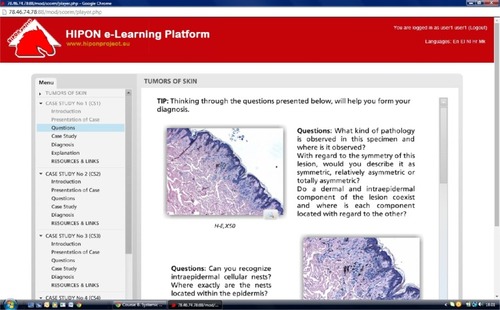
Figure 4 Option of immunohistochemical stain, helpful for defining the correct diagnosis, from a case presentation of an endometrial tumor in HIPON Uterus chapter.
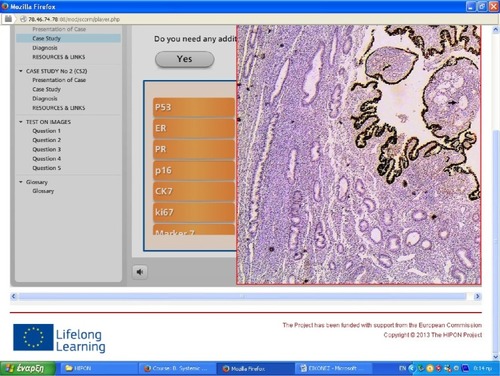
Image-based tests
The degree of consolidation of the users’ diagnostic experience can be estimated by an image-based test, present at the section that closes every chapter. We can mention as an example, the image-based test of the Prostate gland chapter. In this test, the users have to identify specific histological features on their own by answering single-answer or multiple-choice, image-based questions as well as by matching the microscopic features shown in images with the relevant morphological terms (). Then, a review of the test is provided and, in this chapter, it is complemented by an original PowerPoint link in which the answers to the test questions are thoroughly explained.
Conclusion
By doing all this, HIPON aims to make end-users able to think as experienced pathologists and become highly competent in approaching tissue specimens, recognizing patterns of injury and correlating them with both the underlying mechanisms of disease and the clinical data. HIPON thus claims to be in harmony with all four aims set by the “European Union strategic framework for education and training” ie, making lifelong learning and mobility a reality, improving the quality and efficiency of education and training, promoting equity and social cohesion and enhancing creativity and innovation, at all levels of education and training.
Acknowledgments
All authors express their gratitude to the staff of AVMap Group of Companies for their administrative support.
Disclosure
The authors report no conflicts of interest in this work.
References
- MarshallRCartwrightNMattickKTeaching and learning Pathology: a critical review of the English literatureMed Educ200438330231314996340
- YangAGoelHBryanMThe Picmonic(®) Learning System: enhancing memory retention of medical sciences, using an audiovisual mnemonic Web-based learning platformAdv Med Educ Pract2014512533224868180
- KimSSongSMYoonYISmart learning services based on smart cloud computingSensors (Basel)20111187835785022164048
- AlurPFatimaKJosephRMedical teaching websites: do they reflect the learning paradigm?Med Teach200224442242412193328
- LakshmananALeemanKTBrodskyDParadREvaluation of a web-based portal to improve resident education by neonatology fellowsMed Educ Online2014192440325059834
- CookDLevinsonAJGarsideSDuprasDMErwinPJMontoriVMInstructional design variations in internet-based learning for health professions education: a systemic review and meta-analysisAcad Med201085590992220520049
- CarronPNTruebLYersinBHigh-fidelity simulation in the nonmedical domain: practices and potential transferable competencies for the medical fieldAdv Med Educ Pract2011214915523745086
- Van DijikenPCThevozSJucker-KupperPFeihlFBonvinRWaeberBEvaluation of a case-based interactive approach to teaching pathophysiologyMed Teach2008305e131e13618576183
- DacreJEFoxRAHow should we be teaching our undergraduates?Ann Rheum Dis200059966262710976077
- WeurlanderMMasielloISoderbergMWernersonAMeaningful learning: students’ perceptions of a new form of case seminar in pathologyMed Teach2009316248253
- HamiltonPWWangYMcCulloughSJVirtual microscopy and digital pathology in training and educationAPMIS2012120430531522429213
- HerringtonJKervinLAuthentic learning supported by technology: 10 suggestions and cases of integration in classroomsEMI Educ Media Int2007443219236
- WormBSJensenKDoes peer learning or higher levels of e-learning improve learning abilities? A randomized controlled trialMed Educ Online2013182187724229729

